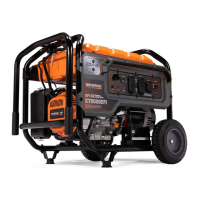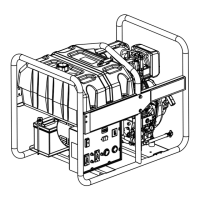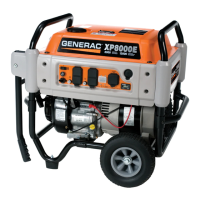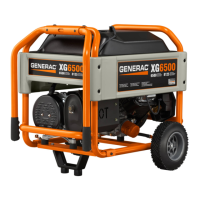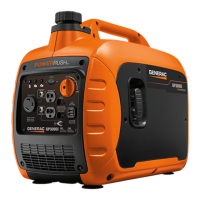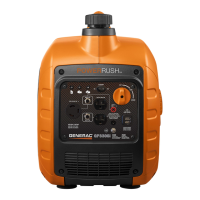Section 5 Engine Diagnostic Tests
Diagnostic Repair Manual 37
to 14 VDC. If voltage is not present, replace
charger. If voltage is present, remove battery
cables from battery.
4. Place meter leads, red to positive cable, and
negative to ground cable. Approximately 13.5 to 14
VDC should be measured. If voltage is not
measured, test battery charge relay. If voltage is
measured, replace battery.
5. The battery charge relay is de-energized when the
generator is off.
6. Remove wiring from battery charge relay. Set DMM
to measure Ohms. Check continuity between
Contacts 1/5 and 2/6. If the contacts read open the
relay should be replaced
Battery Dies When Generator Is Running
1. Make sure generator is producing rated voltage.
2. Set DMM to read DC volts. With generator running,
remove battery cables and place the red meter
lead on positive cable, and negative to ground
cable. 13.5 to 14 VDC should be measured. If
voltage is measured, replace battery. If voltage is
NOT measured, go to step 3.
3. Set DMM to measure Ohms.
4. Remove wires from battery charge relay. With the
generator running and producing voltage, place
one test lead to contact 3 and the other to contact
5. Continuity should be measured. If continuity is
not measured, ohm out the BCR coil. The
resistance should be 3.849kohms. If there is an
open on the coil, replace relay.
Test 36 – Test Battery Charging
Circuit (EFI Electric Start Models)
General Theory
The charging circuit has two wires coming from the
charging coil to the voltage regulator. The regulator
rectifies AC voltage to DC voltage for battery charging on
a single wire with an in-line fuse. Voltage from the
charging coil is unregulated; however, when delivered to
the battery it is regulated.
The battery is constantly being charged during the
operation of the generator. The charge coil is located
under the flywheel and has two yellow wires that lead to a
voltage regulator and then a fuse before going to the
battery via a red wire.
Procedure/Results
NOTE: Check battery condition with a conductance
tester prior to conducting the following test. Battery
condition should be greater than 65%.
1. Start Engine and let run for about a minute.
Measure voltage on battery positive and negative
terminals. Shut engine off.
a. If voltage measured above 13.2 VDC, but less
than 16.0 VDC, stop testing and refer back to
the flowchart. Charging circuit is good.
b. If voltage measured above 16 volts, check
electrolyte level and retest battery.
c. If voltage measured less than 12.5 VDC,
proceed to the next step.
2. Set DMM to measure continuity and check in-line
fuse (on red wire) between solenoid connection
and the voltage regulator.
a. If the fuse measured open (OL), replace fuse.
b. If the fuse measured closed (approximately
0.0), proceed to the next step.
3. Disconnect the connector containing two yellow
wires. Set DMM to AC Voltage function. Measure
AC voltage on the yellow wires/terminals coming
from the charge coil.
a. If voltage was low or NOT measured, replace
the charge coil.
b. If 23 volts ±5 volts was measured, the charge
coil is good. Go to the next step.
4. Reconnect the yellow wire/connector to the charge
coil. Set DMM to DC Voltage. Measure DC voltage
on the red wire leading to the in-line fuse.
a. If 14 volts ±1 volt was measured, the voltage
regulator is good. Refer to the flowchart.
b. If voltage was NOT measured as indicated,
verify Step 2 and replace the voltage regulator.
Test 37 – Test Idle Control
Certain 4000-8000 Watt units are equipped with a low
idle control system. There is a coil mounted near the
engines governor. When the switch is in low idle position,
generator voltage (120 VAC) is fed through the SW3
switch to system control board. The control board will
rectify AC voltage to DC and sends DC voltage to the
coil. The ITC is fed into the control board and when
current starts to flow, the control board will remove DC
voltage from coil to allow engine to run at rated speed.
PROCEDURE
1. Remove all loads from generator.
2. Test low idle switch.
3. Remove wires. Set DMM to Ohms and zero out
meter.
4. With wires removed, place meter leads on the
switch. Place switch to (ON) low idle. The meter
should read CONTINUITY.
5. Place low idle switch to OFF. The meter should
read open.
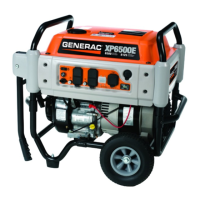
